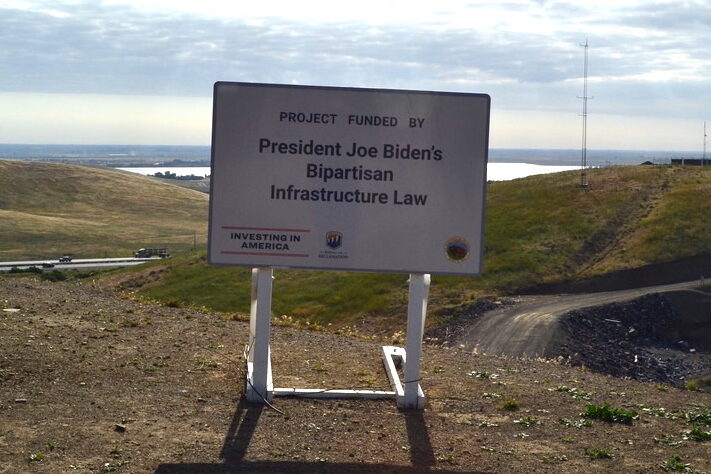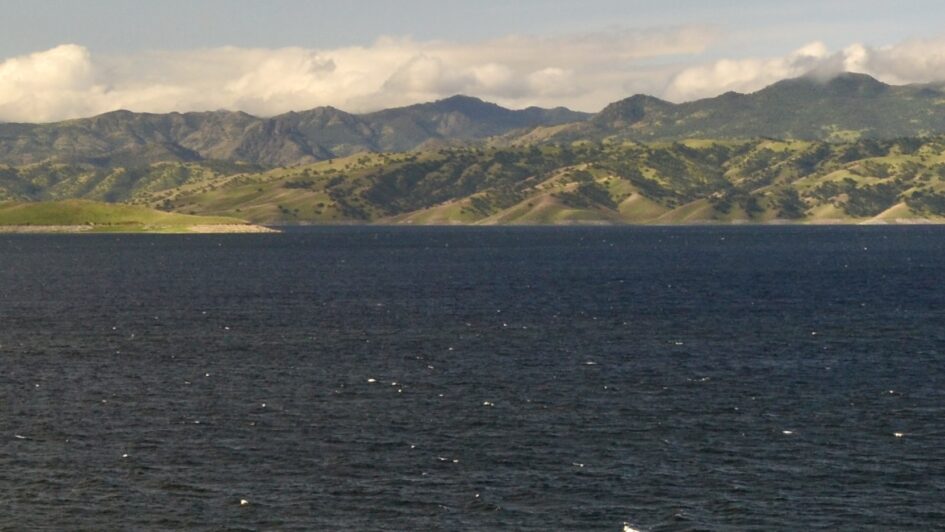I don’t know how many times I’ve driven past the Romero Visitor Center at the San Luis Reservoir near Pacheco Pass. It’s at the end of one of those turnoffs, like the nearby one to Dinosaur Point Campground, that don’t seem to promise enough to make it worth the stop. In my mind, Highway 152 through Pacheco Pass was all about getting somewhere else, not about stopping along the way for a visit. But after a brief spring trip to Los Banos—partly motivated by wanting some breakfast burritos sold at a local Chevron station—I decided to stop.
Inside the visitors’ center are a number of interactive displays that teach about the dam and reservoir, an information kiosk helmed by a very helpful guide, and wide picture windows giving onto panoramic views of the reservoir and surrounding hills, at the time, still mostly green from spring rains.
The reservoir, the fifth largest in California, was then about 75% full, which means it was holding about 1,500,000 acre feet of water (an acre foot equals 325,851gallons) out of a capacity of about 2,000,000. So even though there was a significant ring of bare brown soil exposed between the water’s surface and the vegetation that marks the limit of its reach, that was still a lot of water, all of it pumped uphill for storage from the O’Neill Forebay, which takes water from the California Aqueduct. Then, when the time is right, that water is later released back into the aqueduct to meet downstream needs.
The main attraction of the Romero Visitor Center is an immersive video that takes you on a tour of the inside of the B. F. Sisk Dam. Led by a friendly, hard-hatted, and modestly tattooed woman, the virtual journey features the turbines, generators, and control station inside the vast embankment dam. There’s also some floor rumbling underneath your feet to help sustain the illusion. The main thrust of the virtual tour is to convey the scope of the engineering here, the scale of a complex system that draws power during off peak hours from the grid in order to pump water up into the reservoir and then return power when water is released and turn the dam’s turbine-powered generators. The whole experience made me think of Joan Didion’s essay “Holy Water” and her visit to the center of the Golden State’s water universe.
In that piece, Didion, a splendid critic of Golden State mythology, writes that “not many people I know carry their end of the conversation when I want to talk about water deliveries, even when I stress that these deliveries affect their lives, indirectly, every day. ‘Indirectly’ is not quite enough for most people I know” (“Holy” 62). Didion describes her obsession with waterworks throughout the globe—the Guri Dam in Venezuela, the Aswan in Egypt, for instance—as explanation for how “some of us who live in arid parts of the world think about water with a reverence others might find excessive” (59). She adds,
As it happens my own reverence for water has always taken the form of this constant meditation upon where the water is, of an obsessive interest not in the politics of water but in the waterworks themselves, in the movement of water through aqueducts and siphons and pumps and forebays and afterbays and weirs and drains, in plumbing on the grand scale. (59)
And not surprisingly, given her Sacramento background, she’s especially obsessed with water here in California, which she traces to a teenage experience:
I replay a morning when I was seventeen years old and caught, in a military-surplus life raft, in the construction of the Nimbus Afterbay Dam on the American River near Sacramento. I remember at the moment it happened I was trying to open a tin of anchovies with capers. I recall the raft spinning into the narrow chute through which the river had been temporarily diverted. I recall being deliriously happy.
I suppose it was partly the memory of that delirium that led me to visit, one summer morning in Sacramento, the Operations Control Center for the California State Water Project. (60)
Didion’s “reverence” finds expression in her consuming interest in the particulars of how the State Water Project works, how it controls water throughout the state, reverence evidenced not just by describing what she learns at the Operations Control Center, but also by her fascination with the language of how water is moved:
In practice this requires prodigious coordination, precision, and the best efforts of several human minds and that of a Univac 418. In practice it might be necessary to hold large flows of water for power production, or to flush out encroaching salinity in the Sacramento-San Joaquin Delta, the most ecologically sensitive point on the system. In practice a sudden rain might obviate the need for a delivery when that delivery is already on the way. In practice what is being delivered here is an enormous volume of water, not quarts of milk or spools of thread, and it takes two days to move such a delivery down through Oroville in the Delta, which is the great pooling place for California water and has been for some years alive with electronic sensors and telemetering equipment and men blocking channels and diverting flows and shoveling fish away from the pumps. It takes perhaps another six days to move this same water down the California Aqueduct from the Delta to Tehachapi and put it over the hill to Southern California. “Putting some over the hill” is what they say around the Project Operations Control Center when they want to indicate that they are pumping Aqueduct water from the floor of the San Joaquin Valley up over the Techachapi Mountains. (61)
Thinking of my visit to the Romero Visitor Center, I feel a bit of that fascination, as well as an appreciation for the audacity of scale all this engineering requires. But that kind of audacity, perhaps a common denominator for California’s self-image, needs a sponsor, and historically that sponsor has been the federal government.
In her unconventional 2003 memoir, Where I Was From, Didion notes the contradictions embedded in California, beginning with the reliance on federal money to create and maintain “the entirely artificial environment that is now the Sacramento Valley” (22). Aside from the role of the government in the construction of the railroad that “opened the state to extensive settlement” (25), the federal government, that is, “the citizens of the rest of the country” would
. . . subsidize the crops the railroad carried, make possible the irrigation of millions of acres of essentially arid land, underwrite the rhythms of planting and not planting, and create, finally, a vast agricultural mechanism in a kind of market vacuum, quite remote from the normal necessity for measuring supply against demand and cost against return. As recently as 1993, eighty-two thousand acres in California were still planted in alfalfa, a low-value crop requiring more water than was then used in the households of all thirty million Californians. (25)
The point I take from this passage is less about the inequities of water use in California and more about who, or what, actually controls the resources in our state, citizens of which have traditionally valorized the myth of “unfettered individualism” (23). Or in other words,
It is easy to forget that the only natural force over which we have any control out here is water, and that only recently. In my memory California summers were characterized by the coughing in the pipes that meant the well was dry, and California winters by all-night watches on rivers about to crest, by sandbagging, by dynamite on the levees and flooding on the first floor. . . . The apparent ease of California life is an illusion, and those who believe the illusion real live here in only the most temporary way. I know as well as the next person that there is considerable transcendent value in a river running wild and undammed, a river running free over granite, but I have also lived beneath such a river when it was running in flood, and gone without showers when it was running dry. (“Holy” 64)
In a recent bid to extend control over even more of California’s most precious resource, the federal government—through the agency of the Department of the Interior —is helping to fund a major expansion of San Luis Reservoir by raising the height of the B. F. Sisk dam by 10 feet, adding an estimated 130,000 acre feet of water storage while improving seismic safety. According to a recent press release, construction will result in an “additional water supply for two million people, over one million acres of farmland and 135,000 acres of Pacific Flyway wetlands and critical wildlife habitat.” The project will likely take 10 years to complete.
Drive by the dam these days on Highway 152 between the O’Neill Forebay and the dam, and on the west side you may see orange earth movers—that is, giant dump trucks that, close up, dwarf a human being—moving up and down the enormous earthen dam face. From the highway, they appear no bigger than ants hauling bits of crumb along well-worn paths. If you happen to stop at the Romero Visitor Center, look out the window that opens onto a southeast view of the current dam crest and the Central Valley beyond. You’ll also see a helpful sign that announces:

At least you know where some of your federal tax dollars have gone.
Sources
“Biden-Harris Administration and San Luis & Delta-Mendota Water Authority Approve Plan for B.F. Sisk Dam Project, Advancing Water Supply Reliability and Public Safety in California’s Central Valley.” U.S. Department of the Interior. 20 October 2023. https://www.doi.gov/pressreleases/biden-harris-administration-and-san-luis-delta-mendota-water-authority-approve-plan-bf. Accessed 9 July 2024.
Didion, Joan. Where I Was From. Knopf, 2003.
—. The White Album. 1979. Pocket Books, 1980.
San Luis Reservoir. California Data Exchange Center. California Department of Water Resources. State of California, 2024. https://cdec.water.ca.gov/dynamicapp/QueryMonthly?s=SNL&end=2024-07. Accessed 9 July 2024.
Want to be notified when new posts are added? Subscribe to our newsletter.

